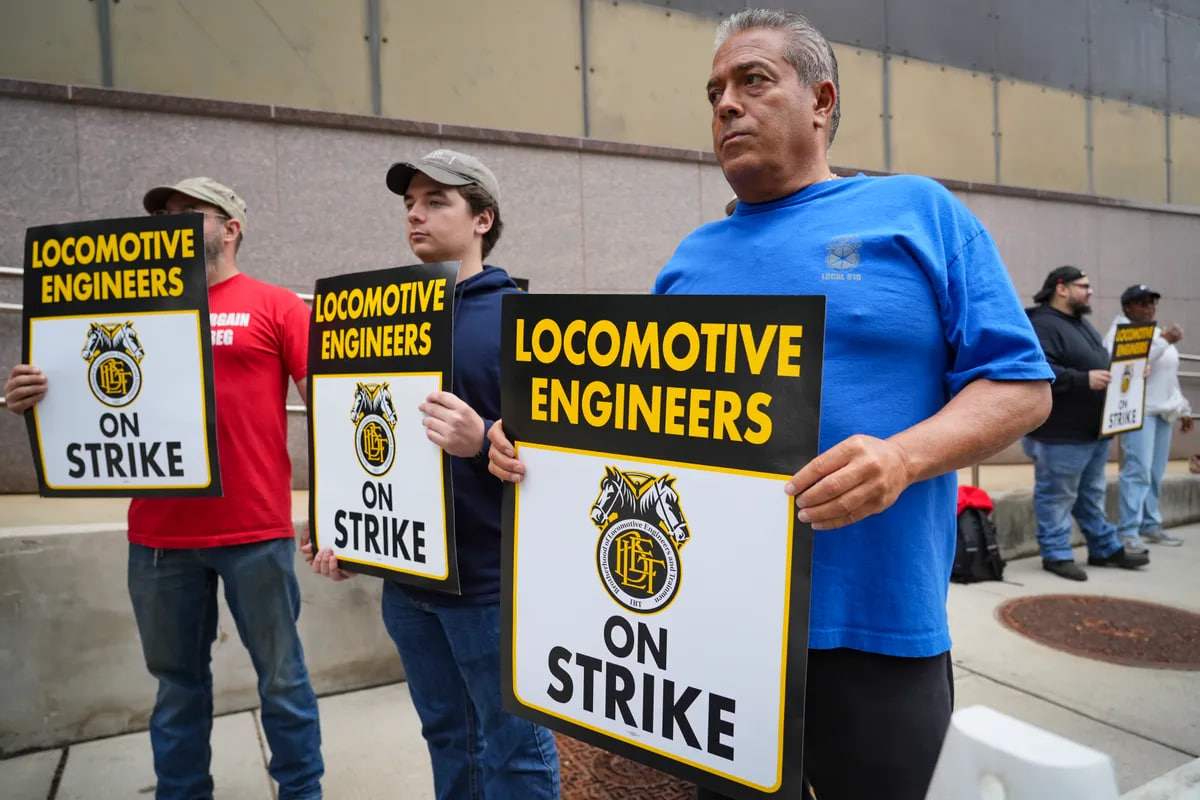The second day of the NJ Transit strike, which began on Friday, saw railroad operations significantly disrupted as locomotive engineers continued their walkout. On the afternoon of Saturday, May 17, representatives from NJ Transit and the Brotherhood of Locomotive Engineers and Trainmen (BLET) union returned to the negotiating table for several hours in an effort to resolve the labor dispute. This session marked a crucial point in the ongoing strike, impacting hundreds of thousands of daily commuters.
Following the discussions on Saturday, both sides provided updates on the status of the negotiations. Kris Kolluri, the CEO and president of NJ Transit, issued a statement characterizing the bargaining session as productive. Kolluri specifically stated, “Today’s discussions continued to be constructive”. While a final agreement was not reached during the Saturday talks, Kolluri indicated that both parties had “mutually agreed to adjourn formal discussions for the day”. Despite this adjournment, the lines of communication were set to remain open, with Kolluri adding, “but will continue talking and look forward to resuming discussions tomorrow”. The agreement to continue formal talks on Sunday underscored a willingness from both the transit agency and the union to keep working towards a resolution.
The perspective from the union side mirrored some of this positive sentiment regarding the negotiation process on Saturday. A representative for the Brotherhood of Locomotive Engineers and Trainmen union confirmed that talks would indeed resume on Sunday. As union representatives departed from the meeting on Saturday, News 12 spoke with BLET General Chairman Tom Haas, who expressed a degree of optimism about the path forward. Haas commented, “…We’re sitting down and talking, we’re moving in the right direction”. This statement from the union’s general chairman echoed NJ Transit CEO Kolluri’s assessment that the discussions were progressing constructively.
Haas also provided insight into the complexity of the long-standing dispute, noting that while they are “about 95% of the way there,” this has been the case for the last two years. He explained that it is “just these last few issues that have been so difficult to work out”. This indicated that despite the apparent progress in recent discussions, significant hurdles remained regarding a few specific points of contention that have been unresolved for an extended period.
In an effort to facilitate further progress, both NJ Transit and the union have agreed to involve the National Mediation Board. Discussions with the National Mediation Board were scheduled to continue on Sunday, May 18. The involvement of this federal agency highlights the importance of finding a mediated solution to end the strike that affects approximately 350,000 daily riders.
The strike itself involves approximately 400 engineers and trainees who stepped off the job and onto the picket lines on Friday. These BLET members were stationed at various locations across multiple states affected by the NJ Transit rail system, including New York, New Jersey, and Pennsylvania. At train stations and rail yards, the striking engineers were observed hoisting signs to inform passersby about their strike and the reasons behind it. Despite being on strike, General Chairman Tom Haas conveyed the sentiment of his members, stating, “We want to be back at work. We want to be running the trains. My guys would like nothing more than to be at work and not out here”. This suggests that the engineers view the strike as a necessary step to achieve their goals, rather than a desired outcome in itself.
While the locomotive engineers were on strike, the vast majority of NJ Transit’s broader workforce continued to report for duty on the first day of the strike. This included rail workers who are not locomotive engineers. According to a source close to the negotiations, this widespread turnout from other employees helped NJ Transit manage the initial impact of the strike. NJ Transit CEO Kris Kolluri publicly recognized the efforts of these employees. Kolluri expressed his gratitude for the “extraordinary work of men and women at NJ Transit to step up and try to meet this moment”. He specifically mentioned the work of bus drivers, police officers, and various other staffers who played a crucial role in helping the first day of the strike unfold relatively smoothly. Their efforts ranged from ensuring bus service operations to assisting customers in navigating the disrupted system at train stations. Kolluri noted that their dedication was aimed at “try[ing] to make the lives of the customers a little bit easier as they navigate this really challenging moment”.
In response to the significant disruption caused by the strike affecting 172,000 weekday rail riders, NJ Transit officials have implemented extensive contingency plans. The primary strategy has been to significantly increase bus service, putting it into “hyperdrive”. Starting May 19, NJ Transit planned to add bus service on specific routes designed to align with the affected rail lines. Furthermore, to provide alternative commuting options, NJ Transit announced the creation of four new park-and-ride locations. These new options are situated at key points: Hamilton Train Station, Secaucus Junction, Woodbridge Center, and PNC Bank Arts Center.
Beyond NJ Transit’s own efforts, other transportation providers have also stepped up to assist affected customers. Amtrak, PATH trains, various ferry services, and private bus companies are all increasing their services to help accommodate the influx of displaced NJ Transit rail passengers. These combined efforts aim to provide alternative ways for commuters to reach their destinations.
Despite these mitigation efforts, the strike has undoubtedly created significant challenges for many regular rail commuters. Alexandra Weiss, a resident of Orange, shared her experience on Friday, May 17, the first day of the strike. She was forced to drive into work for her job in events planning, anticipating a potentially lengthy commute of two hours. While her drive was going smoothly so far, she noted the financial burden compared to her usual train commute. Normally, her round trip on NJ Transit’s Morris & Essex line combined with the subway costs her about $20 a day. Driving, however, is proving to be more expensive, and this added cost was accumulating.
Weiss also voiced concerns about the suitability of the alternative transportation options provided for all commuters. She found that the extra bus service and buses directed towards Port Authority were “none of it is helpful to someone who doesn’t work 9-5 Monday through Friday”. Weiss, whose work schedule often differs from the standard weekday peak hours, felt that the contingency plans, which primarily focused on extra busing and light rail services available mainly on weekdays and during peak hours, were “a little myopic”. She acknowledged NJ Transit’s encouragement for people to work from home if possible but felt that more consideration should have been given to those, like herself, who cannot work remotely and work outside of conventional hours. Weiss questioned, “What about us?” highlighting the challenges faced by commuters with less standard schedules.
The impact of the strike was also visible on the weekend, particularly for those who typically rely on NJ Transit rail for Saturday travel. While most New Jersey rail riders faced difficulties getting into New York on Saturday afternoon, those living closer to the city experienced fewer problems. Residents of Hudson County, for example, were able to access Hoboken Terminal relatively easily because the rail lines serving that immediate area were operating despite the main NJ Transit rail strike. Specifically, PATH trains and NJ Transit’s Hudson Bergen Light Rail were running.
However, even these operational services were not without their typical issues, which were described as “normal conditions” for weekend riders. These included common complaints such as delayed trains, skipped stations, and spotty air conditioning.
One such weekend rider was Joe Russo, who was traveling from Hoboken to the Bronx on Saturday afternoon to watch the Yankees play the Mets. Russo expressed relief that the Light Rail and PATH services were running. Wearing an Aaron Judge jersey while waiting at the 9th Street Light Rail station, Russo commented, “I don’t know what we would do,” emphasizing the necessity of these services for his travel plans. He noted that driving or taking a Lyft would simply be “too expensive” for his trip. Russo and his three friends then boarded a train car where the air conditioning was not functioning. He joked about the experience, saying, “Just another day on the train,” indicating that such issues were not uncommon.
While the PATH and Light Rail sections of Hoboken Terminal saw a moderate number of passengers on Saturday, the large portion of the station typically used by NJ Transit trains was notably quiet and deserted. The 18 tracks that normally facilitate countless train movements were “laid bare” on Saturday afternoon. Access to each platform was restricted, with gates locked. The large electronic boards that usually display departure and arrival information for NJ Transit trains were empty. This visual emptiness underscored the significant impact of the strike on the heart of the rail network.
Another commuter navigating the changed landscape was Hector Ortiz, who traveled from Bayonne using the Light Rail to reach Hoboken Terminal. His goal was to catch a PATH train from Hoboken to get to his restaurant job in Manhattan. Ortiz acknowledged that his current commute strategy was working for him. However, he expressed concern for others, noting that “there’s a lot of people who can’t get to work because of all this”. This highlighted that while some commuters had found alternative routes that worked, many others remained significantly impacted by the cessation of NJ Transit rail service.
Amidst the disruption and the visible impact at key transit hubs like Hoboken Terminal, there was a clear hope among commuters for a swift resolution. Hector Ortiz, like many others, articulated this sentiment, stating, “I hope they get a deal before Monday”. The urgency stemmed from the anticipated increased demand and congestion that would likely arise on Monday morning, the start of a new work week, if the strike were to continue.
As negotiations were set to resume on Sunday with the involvement of the National Mediation Board, the focus remained on whether the “last few issues” that BLET General Chairman Tom Haas mentioned could finally be resolved. The stated goal from both sides was to move “in the right direction” and find a way to get the engineers back to running the trains. The coming days would be critical in determining the duration of the strike and its continued impact on the hundreds of thousands of daily riders who rely on the NJ Transit rail system.

